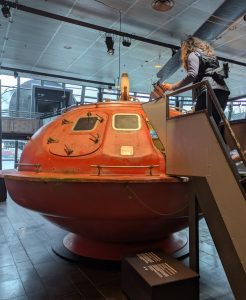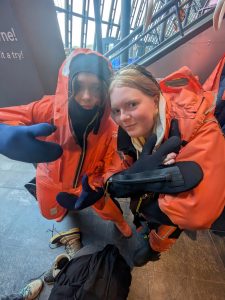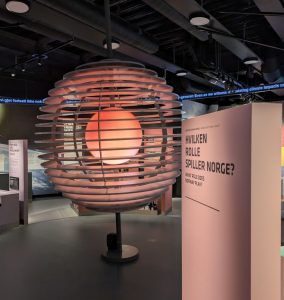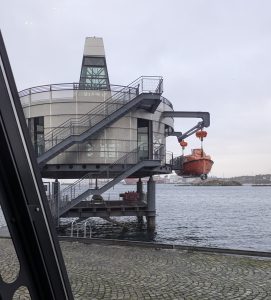Written by Ada Vanderbilt, Clare Hinnenkamp, John Arnell, and Kyle Johnston
Over the course of the trip so far, and while being in Stavanger, we have been watching a show called Lykkeland (State of Happiness). The historical fiction show is set in the 1970s as the oil industry in Stavanger starts to boom. The oil industry was the cause of a large amount of migration to Norway due to the increased need for labor. At the conclusion of the first season, we took a walking tour of Stavanger to look at places seen in the show and learn more about the history of the town. Following the walking tour, we all did self-guided tours in the Stavanger Petroleum Museum to learn more about the oil industry in Norway. The museum was interactive and informative, reminiscent of the Minnesota Science Museum.
As we stepped into the museum, we were greeted with multiple interactive activities to engage with. What immediately intrigued most of us was the lifeboat capsule used to evacuate personnel from platforms during emergencies. We had the opportunity to sit where each passenger would have sat and observe the 26 available spaces in the cramped, claustrophobic environment. We were free to explore at our own pace and choose which exhibits to engage with. Another highly interactive activity was the mock safety training called the “Catastrophe Room,” where we navigated a pitch-black corridor filled with strange doorways and windows, all while air blew on us and loud alarms blared. The best time to complete the course was just 15 seconds. The museum also featured models of various milestones and the engineering behind large underwater structures.


One of the exhibits that particularly caught our eyes was the “Climate For Changed” exhibition in one of the model oil cabins integrated into the architecture of the museum. Norway is known for its eco-conscious attitudes, seen in its carbon-neutral initiatives and walkable cities, but it contradicts its role in the oil industry. Unlike many countries, Norway acknowledges its faults in this exhibition and how they are striving to help the environment. The information is around a large sun-like orb that intermittently flashes red and orange hues. It was cool to see how the Petroleum Museum owns up to how the oil industry impacts the environment and calls out other large countries for their environmental impacts. It acknowledged how everyone can play a part in helping fight global warming, but put pressure on major corporations and large countries.

Having prior background knowledge from Lykkeland, we were able to connect the thrilling drama television experience to the large displays at Stavanger’s Petroleum Museum. This was not only an educational experience, but it also gave us the fun opportunity to expand our knowledge on our final day in the beautiful oil capital of Norway.
